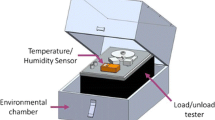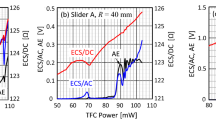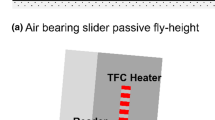Abstract
In this investigation, we examine wear of thermal flying height control sliders as a function of DC bias voltage across the head–disk interface, relative humidity, and lubricant type. Wear tests were conducted using two different experimental setups, a load/unload tester, and a spin-stand tester with relative humidity control. Head wear was determined by measuring the change in the heater touch-down power (ΔTDP) before and after wear testing. After wear testing, selected recording heads were examined using atomic force microscopy and time of flight secondary ion mass spectrometry to investigate wear and deposit formation in the read/write region. Our results show that the polarity of the head–disk interface bias voltage and the relative humidity influence deposit formation and wear in the read/write region of recording heads.
















Similar content being viewed by others
References
Machtle, P., Berger, R., Dietzel, A., Despont, M., Haberle, W., Stutz, R., Binnig, G.K., Vettiger, P.: Integrated microheaters for in situ flying-height control of sliders used in hard-disk drives. In: Technical Digest. MEMS 2001. 14th IEEE International Conference on Micro Electro Mechanical Systems (Cat. No.01CH37090), pp. 196–199 (2001)
Knigge, B., Marchon, B.: Negative biasing a slider with respect to a disk to reduce slider wear and provide burnish rate control (US 8,139,309 B2), 8,139,309 (2012)
Contreras, J., Franca-Neto, L., Knigge, B.: Integrated slider bias control. US 8,049,984 B2
Rajauria, S., Schreck, E., Marchon, B.: Voltage assisted asymmetric nanoscale wear on ultra-smooth diamond like carbon thin films at high sliding speeds. Sci. Rep. 6, 2543 (2016)
Suk, M., Kroeker, R., Gills, D.: Investigation of slider dynamics under electro-static force. Microsyst. Technol. 9, 256–265 (2003)
Knigge, B.E., Mate, C.M., Ruiz, O., Baumgart, P.M.: Influence of contact potential on slider-disk spacing: simulation and experiment. IEEE Trans. Magn. 40(4), 3165–3167 (2004)
Wallash, A.J.: Electrostatic discharge and electrical breakdown study of the head–disk interface in a hard disk drive. IEEE Trans. Magn. 40(3), 1751–1755 (2004)
Matsunuma, S.: The initial step of tribochemical reactions of perfluoropolyether on amorphous carbon. Wear 213, 112–116 (1997)
Spada, F.E., Basov, D.: Fourier transform infrared investigation of thin perfluoropolyether films exposed to electric fields. Tribol. Lett. 8, 179–186 (2000)
Tyndall, G.W., Leezenberg, P.B., Waltman, R.J., Castenada, J.: Interfacial interactions of perfluoropolyether lubricants with magnetic recording media. Tribol. Lett. 4(2), 103–108 (1998)
Kasai, P.H., Raman, V.: Lubricant transfer in disk drives. Tribol. Lett. 48(3), 367–374 (2012)
Feng, Z., Cha, E., Zhang, X.: A study of electrical charge at head–disk interface. Tribol. Lett. 18(1), 53–57 (2005)
Zhang, M., Liu, B.: Measurement of contact potential difference in head disk interface by readback signal spectrum. Microsyst. Technol. 18, 599–602 (2012)
Lacey, C.: MicroPhysics, Inc. 1992. http://www.microphysics.com/
I. Keithley Instruments: Model 2400 Series SourceMeter User’s Manual. Seventh Printing, Cleveland, Ohio, p. 593 (2002)
Wahl, M.H., Lee, P.R., Talke, F.E.: An efficient finite element-based air bearing simulator for pivoted slider bearings using bi-conjugate gradient algorithms. Tribol. Trans. 39, 130–138 (1996)
Matthes, L.M., Brunner, R., Knigge, B., Talke, F.E.: Head wear of thermal flying height control sliders as a function of bonded lubricant ratio, temperature, and relative humidity. Tribol. Lett. 60(3), 39 (2015)
Marchon, B., Heiman, N., Khan, M.R.: Evidence for tribochemical wear on amorphous carbon thin films. IEEE Trans. Magn. 26(1), 168–170 (1990)
Tani, H., Koganezawa, S., Tagawa, N.: Reduction in lubricant pickup by bias voltage between slider and disk surfaces. Microsyst. Technol. 22(6), 1221–1225 (2016)
Karis, T.E., Tawakkul, M.A.: Water adsorption and friction on thin film magnetic recording disks. Tribol. Trans. 46(3), 469–478 (2003)
Yanagisawa, M.: Water adsorption on lubricated surfaces for magnetic storage devices. Tribol. Trans. 44(2), 197–202 (2001)
Shukla, N., Svedberg, E., van de Verdonk, R.J.M., Ma, X., Gui, J., Gellman, A.J.: Water adsorption on lubricated a-CHx in humid environments. Tribol. Lett. 15(1), 9–14 (2003)
Smallen, M., Lee, J.K., Chao, A., Enguero, J.: The role of disk carbon and slider in water adsorption. IEEE Trans. Magn. 30(6), 4137–4139 (1994)
Nakayama, K., Martin, J.M.: Tribochemical reactions at and in the vicinity of a sliding contact. Wear 261, 235–240 (2006)
Spada, F.E., Paul, D.F., Hammond, J.S.: Application of surface analytical techniques for understanding deposit formation on magnetic tape recording head surfaces. Microsc. Microanal. 18(S2), 874–875 (2012)
Acknowledgements
The authors would like to thank Daniel K. Bilich for conducting the TOF-SIMS measurements and valuable discussions.
Author information
Authors and Affiliations
Corresponding author
Rights and permissions
About this article
Cite this article
Matthes, L.M., Spada, F.E., Ovcharenko, A. et al. Effect of Head–Disk Interface Biasing and Relative Humidity on Wear of Thermal Flying Height Control Sliders. Tribol Lett 65, 44 (2017). https://doi.org/10.1007/s11249-017-0828-6
Received:
Accepted:
Published:
DOI: https://doi.org/10.1007/s11249-017-0828-6




